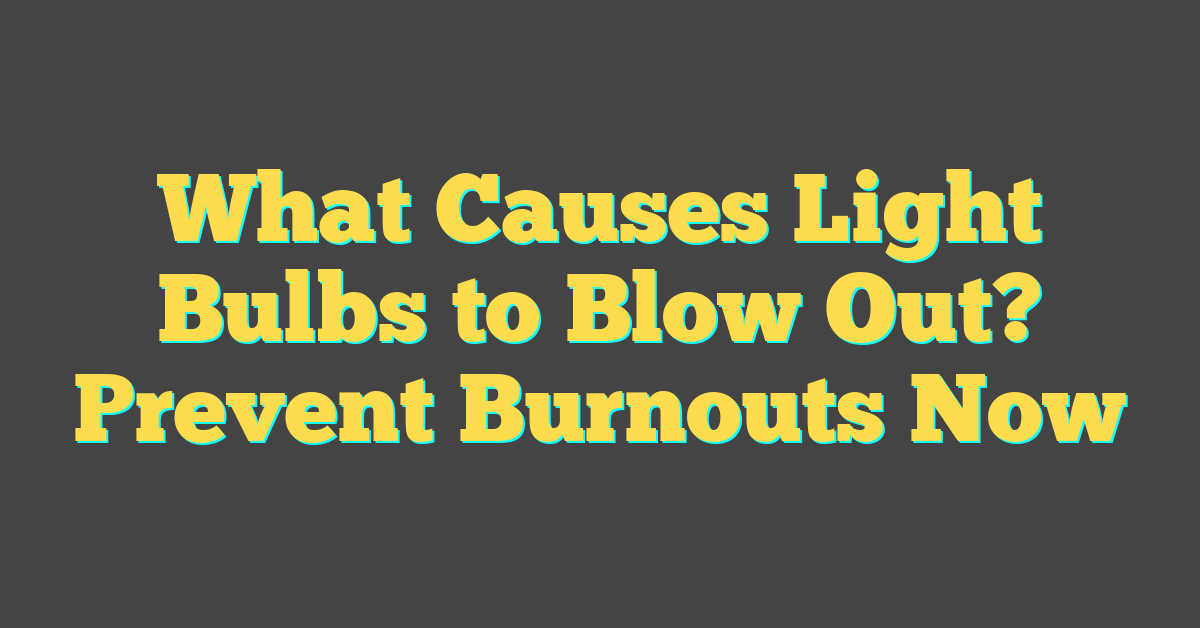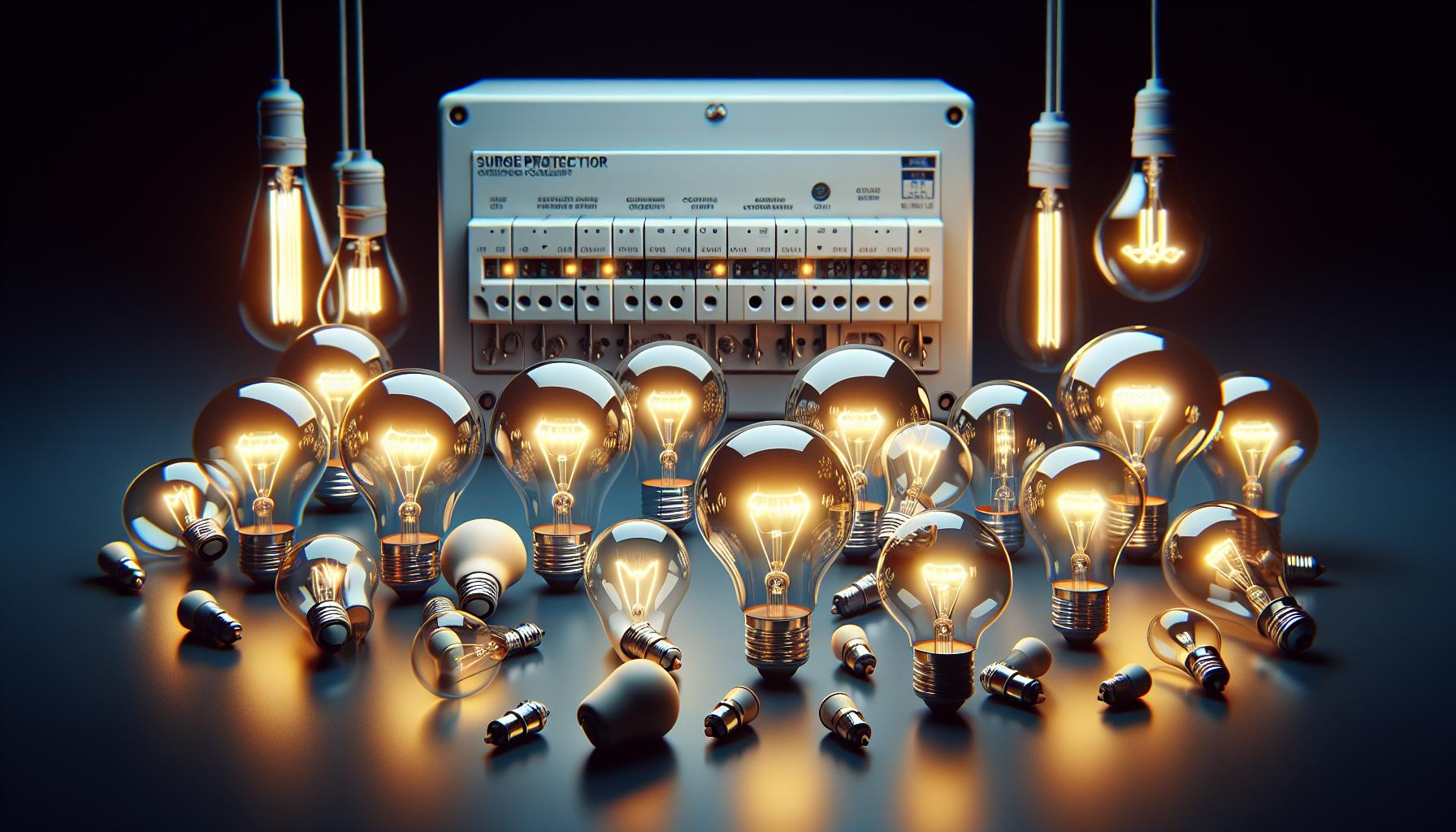Ever been startled by that sudden pop when a light bulb calls it quits? It’s like it’s saying, “Hey, pay attention to me!” But what actually makes them go out with such a bang?

You might think it’s just bad luck, but there’s usually a science to why your bulbs are biting the dust. Let’s shed some light on the common culprits behind your light bulbs’ untimely demise.
Age of the Bulb
When you flip the switch and a bulb fizzles out, it’s often simply due to age. Like any product, light bulbs have a lifespan, which can vary widely based on the type of bulb, usage patterns, and quality.
- Incandescent bulbs typically last between 750 to 2,000 hours.
- Halogen light sources can shine for about 2,000 to 4,000 hours.
- Compact fluorescents (CFLs) are expected to last 6,000 to 15,000 hours.
- LEDs, the long-lasting contenders, shine brightly for a substantial 15,000 to 50,000 hours.
Here’s a simple breakdown:
| Bulb Type | Expected Lifespan (hours) |
|---|---|
| Incandescent | 750 – 2,000 |
| Halogen | 2,000 – 4,000 |
| Compact Fluorescent | 6,000 – 15,000 |
| LED | 15,000 – 50,000 |
Those numbers, however, assume ideal conditions—real-world factors often shorten these estimates. Power surges, frequent switching on and off, and even the mounting position can affect a bulb’s life.
If you’re passionate about home DIY projects and lighting, knowing the age and usage patterns of your bulbs can be crucial. Tracking these can help you anticipate burnouts and replace bulbs preemptively, especially in hard-to-reach places.
The psychology behind keeping the lights on is fascinating. There’s a certain comfort that comes with a well-lit space—whether you’re curling up with a book, highlighting your kitchen’s best features, or illuminating a hand-crafted piece of art. It’s all too common to become attached to the ambience certain lights create, only to be disrupted when a trusty bulb reaches the end of its life.
When you handle replacement, bear in mind the worn-out bulb’s type and how long it served you. Consider upgrading to an LED if longevity is your goal. Not only are they more energy-efficient, but they’re also less prone to unexpected blowouts, making your lighting projects more reliable over time.
Power Surge

Imagine this: you’re enjoying a quiet evening at home when suddenly, all your lights flicker and go out, only to return a moment later. What just happened? That’s a classic sign of a power surge – a spike in your electrical system’s current. They’re notorious for sending your bulbs to an early grave.
Power surges can result from a variety of sources:
- Lightning strikes
- High-power electrical devices turning on and off
- Faulty wiring
- Issues with the utility company’s equipment
When a surge flows through your wiring, it’s like a tidal wave of electricity crashing through the delicate filaments of your bulbs. Now, depending on the kind of bulb you have, the impact can vary. Incandescents are especially vulnerable—like a surfer wiped out by a rogue wave—while LEDs and CFLs might ride it out better due to their design, but they are not immune.
To ferret out the likelihood of power surges in your home, you need to keep an eye on the signs. Maybe you’ve noticed your lights dimming or flickering when your air conditioner kicks in. That’s a telltale sign that you’ve got high-powered appliances taxing your system, potentially leading to surges.
Here’s an essential tip: surge protectors are your best defense. Think of them as the breakwater that reduces the force of the wave before it hits your shores. Quality surge protectors can absorb the extra current and protect your electronics, including your cherished light bulbs.
Let’s break down some key statistics:
| Bulb Type | Surge Susceptibility |
|---|---|
| Incandescent | High |
| LED | Medium |
| CFL | Medium |
« What Light Bulbs Are Healthy? Discover the Safest Options for Your Home
Is Light Bulbs Gas? Unlock the Secrets to Longer Lasting Illumination »
By understanding and mitigating power surges, you can save yourself the headache – and cost – of frequently replacing bulbs in your home. Take preventive measures like installing surge protectors or investing in bulbs that can endure spikes to ensure your well-lit space stays just that.
Voltage Fluctuations

You know how frustrating it is when you’ve just replaced a bulb, and it blows out again without warning? Well, one of the sneakier culprits could be lurking right within your home’s walls: voltage fluctuations. As a home DIY enthusiast and lighting aficionado, you’ve likely encountered the term, but what does it really mean for the lifespan of your bulbs?
Voltage fluctuations are essentially changes in the electrical supply that can climb above or dip below the standard levels your bulbs expect to operate within. For most U.S. homes, this standard level is 120 volts. But when it strays from this sweet spot, even briefly, it can spell trouble.
Why Do Fluctuations Occur?
- Heavy-duty appliances switching on or off
- Faulty wiring that can’t handle current demands
- Overloaded circuitry
- Inconsistent supply from the grid
These are just a few reasons that might cause your lights to get more juice than they can handle, or not enough to function properly.
Imagine you’re sipping from a straw and someone suddenly pinches it; that’s akin to ‘brownouts’ or ‘sags’. On the flip side, if someone forcibly blows air into your straw while you’re sipping, the sudden pressure increase could cause you to choke. This is similar to ‘overvoltages’ or ‘spikes’—they can overwhelm and ultimately pop your bulbs.
Protect Your Bulbs
To safeguard your lights against voltage fluctuations, consider:
- Power Conditioners: These devices can regulate and stabilize the voltage in your home.
- Installing Dedicated Circuits: Appliances that draw a lot of power, like air conditioners, should be on their own circuit to minimize impact on lighting.
- Regular Wiring Checks: Keep an eye out for signs of faulty wiring, such as flickering lights or outlets that spark.
Remember, maintaining steady voltage isn’t just about keeping the lights on; it’s also a question of safety and efficiency. By paying attention to these issues, you can extend the life of your bulbs and keep your cozy corners well-lit for your next project.
Overheating
When you’re deep into your home DIY projects, you’re often working with lights, and understanding the cause of their demise can save you from unnecessary frustration. Overheating is a notorious culprit for blowing light bulbs. You need to be aware that when the temperature around a bulb rises too much, it shortens the bulb’s lifespan drastically.
Traditionally, incandescent bulbs are more prone to heat issues because they operate at higher temperatures. Think about it, almost 90% of the energy they use ends up as heat, not light! Now, while modern LED bulbs are cooler, they’re still sensitive creatures. If the heat sink, designed to dissipate heat in LEDs, is covered or faulty, the bulb can overheat and fail.
Here’s what you might find causing the heat build-up:
- Enclosed fixtures that don’t allow for proper ventilation.
- High wattage bulbs not intended for the size or type of fixture you’re using.
- Dimmer switches that might not be compatible with the bulb type, leading to excess heat.
So what can you do to prevent overheating? Here are a few steps:
- Ensure your fixtures are bulb-appropriate; use LEDs or fluorescents for enclosed spaces.
- Double-check that your dimmers are LED-compatible if you’re making the switch from incandescents.
- Always match the wattage requirements of your fixtures with the bulbs you install.
By taking these preventive measures, you’ll reduce the risk of overheating. Your DIY projects will not only look great but also be sustainable, knowing you’ve installed the lighting properly. Plus, you’ll save time and money in the long run by not having to replace your light bulbs as often. Keep an eye on those fixtures and temperatures, and your bulbs will thank you by shining bright and long.
Loose Connections

If you’ve ever flicked a switch and been greeted with a brief flash before darkness, you’ve likely dealt with a loose connection. Loose connections can happen anywhere along the circuit, from the socket to the wiring in your wall. Let’s shine some light on this issue and figure out what you can do about it.
At its simplest, a light bulb requires a solid connection between the electrical circuit and its own contacts to function. When these aren’t snug, electricity can arc or jump across the gap, creating mini power surges that can diminish the bulb’s lifespan or blow it out entirely. You’d be surprised how easy it is for connections to become loose over time, especially with the vibrations caused by appliances, heavy traffic, or even frequent use.
Here are a few tell-tale signs that your light fixtures may be suffering from loose connections:
- Your bulbs frequently burn out faster than expected.
- Lights flicker or dim unexpectedly.
- You hear buzzing sounds from the fixture.
- The bulb seems loose when you touch it.
Preventing these issues can be as simple as ensuring bulbs are properly screwed in, but remember, it’s not just about tightening the bulb. You should also occasionally check the socket itself, as the metal contact tab can become flattened or pushed back, leading to a poor connection. If you fancy yourself a DIY enthusiast, you might be comfortable bending the tab gently back into place; just make sure the power’s off first to stay safe.
For those connections that are out of sight within the walls, it’s crucial to have a qualified electrician take a look if you’re consistently running into issues. It might seem like an annoyance, but addressing these hidden gremlins will keep your home brighter and safer in the long run.
By staying vigilant and inspecting your lighting fixtures, you’ll reduce the risk of troublesome loose connections and keep your lights burning bright and steady. Remember, every element of your lighting setup plays a role in its overall performance and longevity. Keep up with maintenance and your bulbs will thank you for it.
Conclusion
By now you’ve got a good handle on what might be sending your light bulbs to an early grave. Remember, it’s not just about screwing the bulb in and forgetting it. Staying on top of things like ensuring a snug fit and keeping an eye out for any odd behavior from your lights can make all the difference. And when in doubt, don’t hesitate to call in a pro. After all, it’s not just about saving bulbs—it’s about keeping your home safe and well-lit. So go ahead, give your lights a little TLC and they’ll be sure to return the favor with a longer, brighter life.
Frequently Asked Questions
Why do light bulbs fail?
Light bulbs can fail due to several reasons including power surges, voltage fluctuations, overheating, and loose connections. These issues can shorten the lifespan of a bulb or cause it to blow out.
What causes a light bulb to blow out from a loose connection?
Loose connections can create mini power surges when the electricity jumps across the gap, leading to increased heat that may blow out the bulb.
What are the signs of a loose connection in lighting fixtures?
Signs of a loose connection include frequent bulb burnouts, flickering or dimming lights, buzzing sounds, or bulbs that are not screwed in securely.
How can you prevent loose connection issues with light bulbs?
To prevent issues, ensure bulbs are properly screwed in and inspect the socket for any signs of damage or wear, such as flattened or pushed back metal contact tabs.
What should you do if you suspect a loose connection within your walls?
If you suspect a loose connection inside the walls, it’s safest to consult a qualified electrician to inspect and repair any hidden electrical issues.




